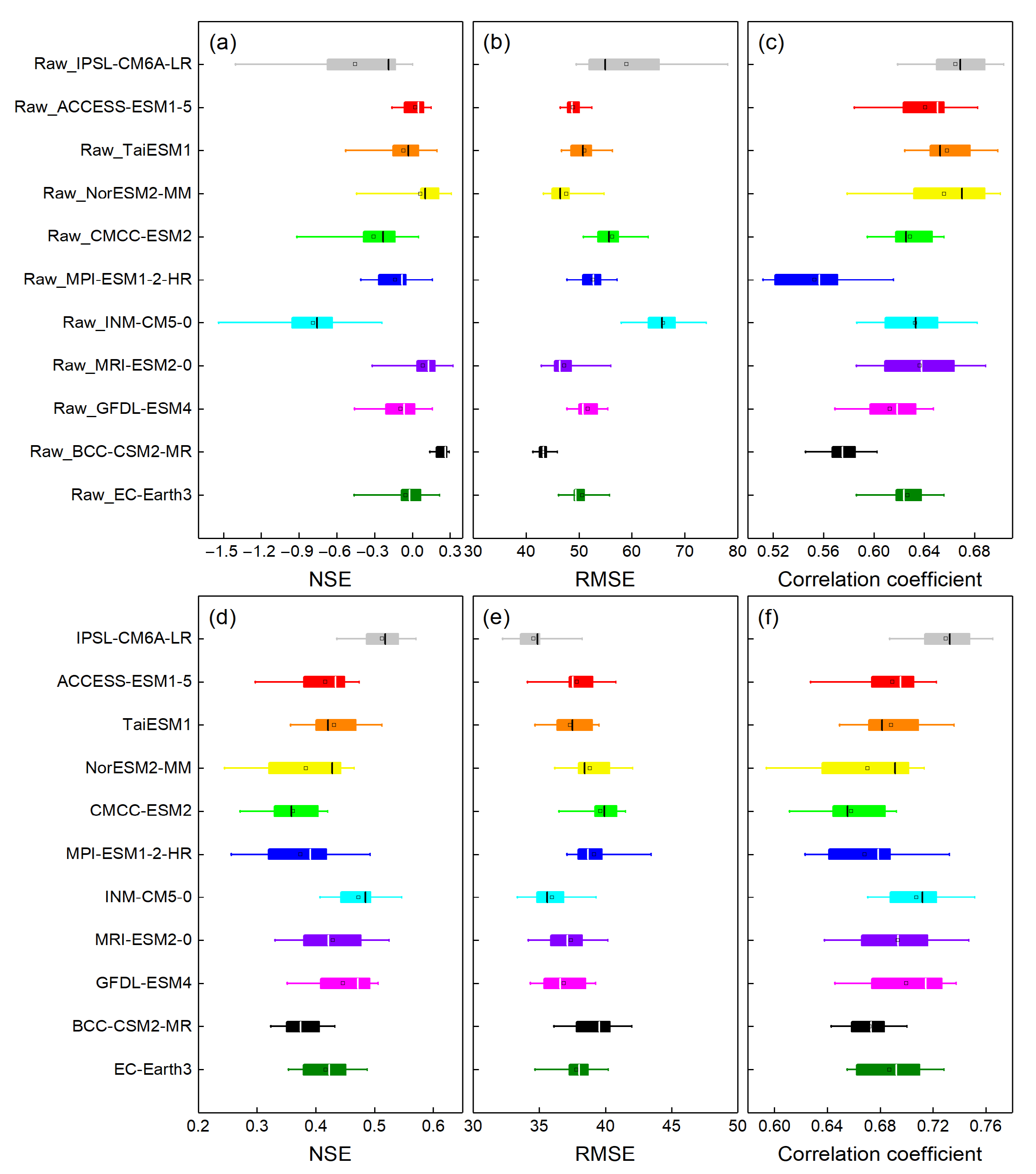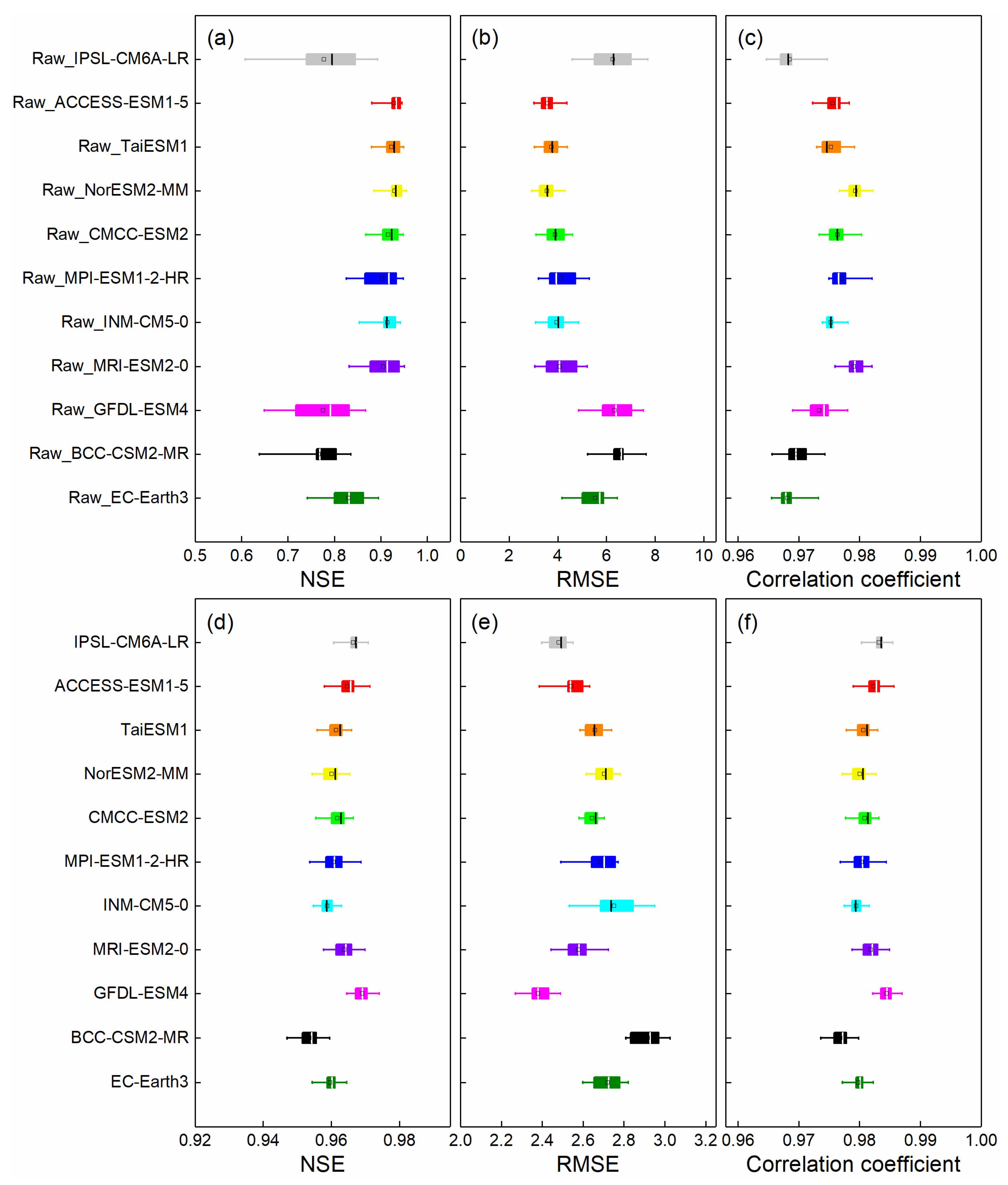Integrated Assessment of Climate-Driven Streamflow Changes in a Transboundary Lake Basin Using CMIP6-SWAT+-BMA: A Sustainability Perspective
Abstract
1. Introduction
2. Materials and Methods
2.1. Study Area
2.2. Selection of GCMs
2.3. Bias Correction
2.4. Bayesian Model Averaging Method
2.5. SWAT+ Model
3. Results
3.1. Evaluation for Historical Climate Variables of GCMs
3.2. Performance Evaluation of Simulated Streamflow in Historical Period
3.3. Streamflow Simulation and Prediction Based on Multi-Model Weighted Average Ensemble
4. Discussion
4.1. Evaluation of GCM Performance and Bias Correction
4.2. Uncertainty of Streamflow Projections
4.3. Future Streamflow Changes and Potential Mechanisms of Xiaoxingkai Lake
4.4. Implications for Transboundary Water Resource Management
5. Conclusions
Supplementary Materials
Author Contributions
Funding
Institutional Review Board Statement
Informed Consent Statement
Data Availability Statement
Conflicts of Interest
References
- IPCC. The refinement to the 2006 IPCC guidelines for national greenhouse gas inventories. Fundam. Appl. Climatol. 2019, 2, 5–13. [Google Scholar] [CrossRef]
- IPCC. Climate Change 2021—The Physical Science Basis: Working Group I Contribution to the Sixth Assessment Report of the Intergovernmental Panel on Climate Change; Cambridge University Press: Cambridge, UK, 2023. [Google Scholar]
- Yang, D.; Yang, Y.; Xia, J. Hydrological cycle and water resources in a changing world: A review. Geogr. Sustain. 2021, 2, 115–122. [Google Scholar] [CrossRef]
- Labat, D.; Ronchail, J.; Callede, J.; Guyot, J.L.; De Oliveira, E.; Guimaraes, W. Wavelet analysis of Amazon hydrological regime variability. Geophys. Res. Lett. 2004, 31, L02501. [Google Scholar] [CrossRef]
- Li, W.; Liu, H.; Gao, P.; Yang, A.; Fei, Y.; Wen, Y.; Su, Y.; Yuan, X. Development of an MPE-BMA Ensemble Model for Runoff Prediction Under Future Climate Change Scenarios: A Case Study of the Xiangxi River Basin. Sustainability 2025, 17, 4714. [Google Scholar] [CrossRef]
- Faramarzi, M.; Abbaspour, K.C.; Vaghefi, S.A.; Farzaneh, M.R.; Zehnder, A.J.B.; Srinivasan, R.; Yang, H. Modeling impacts of climate change on freshwater availability in Africa. J. Hydrol. 2013, 480, 85–101. [Google Scholar] [CrossRef]
- Zhao, Z.X.; Huo, A.D.; Liu, Q.; Yang, L.Y.; Luo, C.X.; Ahmed, A.; Elbeltagi, A. Assessment of urban inundation and prediction of combined flood disaster in the middle reaches of Yellow river basin under extreme precipitation. J. Hydrol. 2024, 640, 131707. [Google Scholar] [CrossRef]
- Legesse, T.G.; Dong, G.; Dong, X.B.; Qu, L.P.; Chen, B.R.; Daba, N.A.; Sorecha, E.M.; Zhu, W.; Lei, T.A.J.; Shao, C.L. The extreme wet and large precipitation size increase carbon uptake in Eurasian meadow steppes: Evidence from natural and manipulated precipitation experiments. Environ. Res. 2023, 237, 117029. [Google Scholar] [CrossRef] [PubMed]
- Gulahmadov, N.; Chen, Y.N.; Gulakhmadov, A.; Rakhimova, M.; Gulakhmadov, M. Quantifying the Relative Contribution of Climate Change and Anthropogenic Activities on Runoff Variations in the Central Part of Tajikistan in Central Asia. Land 2021, 10, 525. [Google Scholar] [CrossRef]
- Yang, Z.L.; Bai, P. Response of runoff and its components to climate change in the Manas River of the Tian Shan Mountains. Adv. Clim. Change Res. 2024, 15, 62–74. [Google Scholar] [CrossRef]
- Gray, L.C.; Zhao, L.; Stillwell, A.S. Impacts of climate change on global total and urban runoff. J. Hydrol. 2023, 620, 129352. [Google Scholar] [CrossRef]
- Burns, G.Z.; Fowler, K.J.A.; Horne, A.C. Stress testing climate change impacts on snow cover and streamflow in southeast Australia. J. Hydrol. 2024, 644, 132031. [Google Scholar] [CrossRef]
- Deng, C.; Yin, X.; Zou, J.C.; Wang, M.M.; Hou, Y.K. Assessment of the impact of climate change on streamflow of Ganjiang River catchment via LSTM-based models. J. Hydrol.-Reg. Stud. 2024, 52, 101716. [Google Scholar] [CrossRef]
- Tan, L.; Feng, P.; Li, B.; Huang, F.; Liu, D.L.; Ren, P.; Liu, H.; Srinivasan, R.; Chen, Y. Climate change impacts on crop water productivity and net groundwater use under a double-cropping system with intensive irrigation in the Haihe River Basin, China. Agric. Water Manag. 2022, 266, 107560. [Google Scholar] [CrossRef]
- Hamed, M.M.; Nashwan, M.S.; Shahid, S.; bin Ismail, T.; Wang, X.J.; Dewan, A.; Asaduzzaman, M. Inconsistency in historical simulations and future projections of temperature and rainfall: A comparison of CMIP5 and CMIP6 models over Southeast Asia. Atmos. Res. 2022, 265, 105927. [Google Scholar] [CrossRef]
- Song, Y.H.; Nashwan, M.S.; Chung, E.S.; Shahid, S. Advances in CMIP6 INM-CM5 over CMIP5 INM-CM4 for precipitation simulation in South Korea. Atmos. Res. 2021, 247, 105261. [Google Scholar] [CrossRef]
- Jiang, D.; Hu, D.; Tian, Z.; Lang, X. Differences between CMIP6 and CMIP5 Models in Simulating Climate over China and the East Asian Monsoon. Adv. Atmos. Sci. 2020, 37, 1102–1118. [Google Scholar] [CrossRef]
- Try, S.; Tanaka, S.; Tanaka, K.; Sayama, T.; Khujanazarov, T.; Oeurng, C. Comparison of CMIP5 and CMIP6 GCM performance for flood projections in the Mekong River Basin. J. Hydrol. Reg. Stud. 2022, 40, 101035. [Google Scholar] [CrossRef]
- Wang, Y.; Li, H.; Wang, H.; Sun, B.; Chen, H. Evaluation of CMIP6 model simulations of extreme precipitation in China and comparison with CMIP5. Acta Meteorol. Sin. 2021, 79, 369–386. [Google Scholar]
- O’Neill, B.C.; Tebaldi, C.; van Vuuren, D.P.; Eyring, V.; Friedlingstein, P.; Hurtt, G.; Knutti, R.; Kriegler, E.; Lamarque, J.-F.; Lowe, J.; et al. The Scenario Model Intercomparison Project (ScenarioMIP) for CMIP6. Geosci. Model Dev. 2016, 9, 3461–3482. [Google Scholar] [CrossRef]
- Eyring, V.; Bony, S.; Meehl, G.A.; Senior, C.A.; Stevens, B.; Stouffer, R.J.; Taylor, K.E. Overview of the Coupled Model Intercomparison Project Phase 6 (CMIP6) experimental design and organization. Geosci. Model Dev. 2016, 9, 1937–1958. [Google Scholar] [CrossRef]
- Chen, C.; Gan, R.; Feng, D.; Yang, F.; Zuo, Q. Quantifying the contribution of SWAT modeling and CMIP6 inputting to streamflow prediction uncertainty under climate change. J. Clean. Prod. 2022, 364, 132675. [Google Scholar] [CrossRef]
- Zhang, L.; Chen, X.; Xin, X. Short commentary on CMIP6 Scenario Model Intercomparison Project (ScenarioMIP). Clim. Change Res. 2019, 15, 519–525. [Google Scholar] [CrossRef]
- Zhou, J.; Lu, H.; Yang, K.; Jiang, R.; Yang, Y.; Wang, W.; Zhang, X. Projection of China’s future runoff based on the CMIP6 mid-high warming scenarios. Sci. China Earth Sci. 2023, 66, 528–546. [Google Scholar] [CrossRef]
- Jian, S.; Pei, Y.; Zhu, T.; Yu, X. Spatiotemporal change and attribution analysis of future runoff on the Yellow River basin of China. J. Hydrol. Reg. Stud. 2023, 49, 101494. [Google Scholar] [CrossRef]
- Song, Y.H.; Chung, E.S.; Shahid, S. Differences in extremes and uncertainties in future runoff simulations using SWAT and LSTM for SSP scenarios. Sci. Total Environ. 2022, 838, 156162. [Google Scholar] [CrossRef]
- Zhu, L.J.; Zhou, H.X.; Xie, X.Y.; Li, X.K.; Zhang, D.Y.; Jia, L.M.; Wei, Q.B.; Zhao, Y.; Wei, Z.M.; Ma, Y.Y. Effects of floodgates operation on nitrogen transformation in a lake based on structural equation modeling analysis. Sci. Total Environ. 2018, 631–632, 1311–1320. [Google Scholar] [CrossRef]
- Yuan, Y.X.; Jiang, M.; Liu, X.T.; Yu, H.X.; Otte, M.L.; Ma, C.X.; Her, Y.G. Environmental variables influencing phytoplankton communities in hydrologically connected aquatic habitats in the Lake Xingkai basin. Ecol. Indic. 2018, 91, 1–12. [Google Scholar] [CrossRef]
- Xiao, F.Y.; Wang, X.M.; Fu, C.S. Impacts of land use/land cover and climate change on hydrological cycle in the Xiaoxingkai Lake Basin. J. Hydrol.-Reg. Stud. 2023, 47, 101422. [Google Scholar] [CrossRef]
- Song, K.; Wang, Z.; Li, L.; Tedesco, L.; Li, F.; Jin, C.; Du, J. Wetlands shrinkage, fragmentation and their links to agriculture in the Muleng–Xingkai Plain, China. J. Environ. Manag. 2012, 111, 120–132. [Google Scholar] [CrossRef] [PubMed]
- Crosbie, R.S.; Dawes, W.R.; Charles, S.P.; Mpelasoka, F.S.; Summerell, G.K. Differences in future recharge estimates due to GCMs, downscaling methods and hydrological models. Geophys. Res. Lett. 2011, 38, L11406. [Google Scholar] [CrossRef]
- Xiao, D.; Liu, D.L.; Wang, B.; Feng, P.; Tang, J. Climate change impact on yields and water use of wheat and maize in the North China Plain under future climate change scenarios. Agric. Water Manag. 2020, 238, 1–15. [Google Scholar] [CrossRef]
- Asseng, S.; Martre, P.; Maiorano, A.; Rötter, R.P.; Ewert, F. Climate change impact and adaptation for wheat protein. Glob. Change Biol. 2018, 25, 155–173. [Google Scholar] [CrossRef]
- Thomson, A.M.; Brown, R.A.; Rosenberg, N.J.; Srinivasan, R.; Izaurralde, R.C. Climate Change Impacts for the Conterminous USA: An Integrated Assessment Part 4: Water Resources. Clim. Change 2005, 69, 43–65. [Google Scholar] [CrossRef]
- Najafi, M.R.; Moradkhani, H.; Jung, I.W. Assessing the uncertainties of hydrologic model selection in climate change impact studies. Hydrol. Process. 2011, 25, 2814–2826. [Google Scholar] [CrossRef]
- Ashfaq, M.; Rastogi, D.; Kitson, J.; Abid, M.A.; Kao, S.C. Evaluation of CMIP6 GCMs Over the CONUS for Downscaling Studies. J. Geophys. Res. Atmos. 2022, 127, e2022JD036659. [Google Scholar] [CrossRef]
- Li, Z.-L.; Jiao, X.-Z. Evaluation and projections of summer daily precipitation over Northeastern China in an optimal CMIP6 Multimodel Ensemble. Clim. Dyn. 2024, 62, 6235–6251. [Google Scholar] [CrossRef]
- Li, C.; Fang, H. Assessment of climate change impacts on the streamflow for the Mun River in the Mekong Basin, Southeast Asia: Using SWAT model. Catena 2021, 201, 105199. [Google Scholar] [CrossRef]
- Buhay Bucton, B.G.; Shrestha, S.; Kc, S.; Mohanasundaram, S.; Virdis, S.G.P.; Chaowiwat, W. Impacts of climate and land use change on groundwater recharge under shared socioeconomic pathways: A case of Siem Reap, Cambodia. Environ. Res. 2022, 211, 113070. [Google Scholar] [CrossRef]
- Tan, M.L.; Liang, J.; Samat, N.; Chan, N.W.; Haywood, J.M.; Hodges, K. Hydrological Extremes and Responses to Climate Change in the Kelantan River Basin, Malaysia, Based on the CMIP6 HighResMIP Experiments. Water 2021, 13, 1472. [Google Scholar] [CrossRef]
- Maraun, D. Bias Correcting Climate Change Simulations—A Critical Review. Curr. Clim. Change Rep. 2016, 2, 211–220. [Google Scholar] [CrossRef]
- Shrestha, M.; Acharya, S.C.; Shrestha, P.K. Bias correction of climate models for hydrological modelling-are simple methods still useful? Meteorol. Appl. 2017, 24, 531–539. [Google Scholar] [CrossRef]
- Konapala, G.; Mishra, A.K.; Wada, Y.; Mann, M.E. Climate change will affect global water availability through compounding changes in seasonal precipitation and evaporation. Nat. Commun. 2020, 11, 3044. [Google Scholar] [CrossRef]
- Bieger, K.; Arnold, J.G.; Rathjens, H.; White, M.J.; Bosch, D.D.; Allen, P.M.; Volk, M.; Srinivasan, R. Introduction to SWAT+, A Completely Restructured Version of the Soil and Water Assessment Tool. JAWRA J. Am. Water Resour. Assoc. 2017, 53, 115–130. [Google Scholar] [CrossRef]
- Chawanda, C.J.; Nkwasa, A.; Thiery, W.; van Griensven, A. Combined impacts of climate and land-use change on future water resources in Africa. Hydrol. Earth Syst. Sci. 2024, 28, 117–138. [Google Scholar] [CrossRef]
- Mankin, K.R.; Mehan, S.; Green, T.R.; Barnard, D.M. Review of gridded climate products and their use in hydrological analyses reveals overlaps, gaps, and the need for a more objective approach to selecting model forcing datasets. Hydrol. Earth Syst. Sci. 2025, 29, 85–108. [Google Scholar] [CrossRef]
- Carmichael, M.J.; Lunt, D.J.; Huber, M.; Heinemann, M.; Kiehl, J.; LeGrande, A.; Loptson, C.A.; Roberts, C.D.; Sagoo, N.; Shields, C.; et al. A model–model and data–model comparison for the early Eocene hydrological cycle. Clim. Past 2016, 12, 455–481. [Google Scholar] [CrossRef]
- Eghdamirad, S.; Johnson, F.; Sharma, A. How reliable are GCM simulations for different atmospheric variables? Clim. Change 2017, 145, 237–248. [Google Scholar] [CrossRef]
- Brunner, L.; Pendergrass, A.G.; Lehner, F.; Merrifield, A.L.; Lorenz, R.; Knutti, R. Reduced global warming from CMIP6 projections when weighting models by performance and independence. Earth Syst. Dyn. 2020, 11, 995–1012. [Google Scholar] [CrossRef]
- Nguyen, P.L.; Alexander, L.V.; Thatcher, M.J.; Truong, S.C.H.; Isphording, R.N.; McGregor, J.L. Selecting CMIP6 global climate models (GCMs) for Coordinated Regional Climate Downscaling Experiment (CORDEX) dynamical downscaling over Southeast Asia using a standardised benchmarking framework. Geosci. Model Dev. 2024, 17, 7285–7315. [Google Scholar] [CrossRef]
- Majhi, A.; Dhanya, C.T.; Chakma, S. Mutual information based weighted variance approach for uncertainty quantification of climate projections. MethodsX 2023, 10, 102063. [Google Scholar] [CrossRef] [PubMed]
- Sanderson, B.M.; Wehner, M.; Knutti, R. Skill and independence weighting for multi-model assessments. Geosci. Model Dev. 2017, 10, 2379–2395. [Google Scholar] [CrossRef]
- Wang, H.-M.; Chen, J.; Xu, C.-Y.; Chen, H.; Guo, S.; Xie, P.; Li, X. Does the weighting of climate simulations result in a better quantification of hydrological impacts? Hydrol. Earth Syst. Sci. 2019, 23, 4033–4050. [Google Scholar] [CrossRef]
- Fuso, F.; Stucchi, L.; Bonacina, L.; Fornaroli, R.; Bocchiola, D. Evaluation of water temperature under changing climate and its effect on river habitat in a regulated Alpine catchment. J. Hydrol. 2023, 616, 128816. [Google Scholar] [CrossRef]
- Gao, J.; Castelletti, A.; Burlado, P.; Wang, H.; Zhao, J. Soft-cooperation via data sharing eases transboundary conflicts in the Lancang-Mekong River Basin. J. Hydrol. 2022, 606, 127464. [Google Scholar] [CrossRef]
- Zhao, Y.; Zhao, T.; Xiong, X.; Sun, Y. Understanding the conflict and cooperation in the Yarlung Tsangpo-Brahmaputra River Basin under climate change: A quantitative view based on water events. J. Water Clim. Change 2023, 14, 1226–1246. [Google Scholar] [CrossRef]









| ID | Model Name | Institute ID | Country | Resolution | Taylor Skill Score |
|---|---|---|---|---|---|
| 1 | ACCESS-ESM1-5 | BoM | Australia | 250 km | 0.72 |
| 2 | BCC-CSM2-MR | BCC | China | 100 km | 0.66 |
| 3 | CMCC-ESM2 | CMCC | Italy | 100 km | 0.66 |
| 4 | EC-Earth3 | EC-EARTH | European Union | 100 km | 0.70 |
| 5 | GFDL-ESM4 | NOAA GFDL | America | 100 km | 0.70 |
| 6 | INM-CM5-0 | INM | Russia | 100 km | 0.68 |
| 7 | IPSL-CM6A-LR | IPSL | France | 250 km | 0.71 |
| 8 | MPI-ESM1-2-HR | MPI-M | Germany | 100 km | 0.65 |
| 9 | MRI-ESM2-0 | MRI | Japan | 100 km | 0.72 |
| 10 | NorESM-MM | NCC | Norway | 100 km | 0.71 |
| 11 | TaiESM1 | AS-RCEC | Taiwan, China | 100 km | 0.71 |
| Hydrological Stations | Available Data Range | Monthly Streamflow | Average Yearly Streamflow | ||
|---|---|---|---|---|---|
| Average | Maximum (Year-Month) | ||||
| 1 | MuLing | 1962–1987, 2002–2017 | 11.49 | 149.00 (1965-08) | 11.55 |
| 2 | Lishuzhen | 1963–1987, 2002–2017 | 24.81 | 324.00 (1965-08) | 24.94 |
| 3 | QingNianShuiKu | 1961–1987, 2002–2017 | 3.12 | 79.80 (1981-08) | 3.14 |
| 4 | MiShanQiao | 1979–1987, 2002–2017 | 36.69 | 320.00 (2002-08) | 36.89 |
| 5 | HuBeiZha | 1961–1987, 2002–2017 | 47.02 | 568.00 (1965-08) | 47.24 |
| 6 | HuBeiZha (Mu) | 1979–1987, 2002–2011 | 33.34 | 385.00 (1981-08) | 33.53 |
| 7 | YiTong | 1961–1969 | 48.12 | 507.00 (1965-08) | 48.30 |
Disclaimer/Publisher’s Note: The statements, opinions and data contained in all publications are solely those of the individual author(s) and contributor(s) and not of MDPI and/or the editor(s). MDPI and/or the editor(s) disclaim responsibility for any injury to people or property resulting from any ideas, methods, instructions or products referred to in the content. |
© 2025 by the authors. Licensee MDPI, Basel, Switzerland. This article is an open access article distributed under the terms and conditions of the Creative Commons Attribution (CC BY) license (https://creativecommons.org/licenses/by/4.0/).
Share and Cite
Xiao, F.; Wu, Y.; Wang, X.; Wang, P.; Fu, C.; Zhang, J. Integrated Assessment of Climate-Driven Streamflow Changes in a Transboundary Lake Basin Using CMIP6-SWAT+-BMA: A Sustainability Perspective. Sustainability 2025, 17, 7901. https://doi.org/10.3390/su17177901
Xiao F, Wu Y, Wang X, Wang P, Fu C, Zhang J. Integrated Assessment of Climate-Driven Streamflow Changes in a Transboundary Lake Basin Using CMIP6-SWAT+-BMA: A Sustainability Perspective. Sustainability. 2025; 17(17):7901. https://doi.org/10.3390/su17177901
Chicago/Turabian StyleXiao, Feiyan, Yaping Wu, Xunming Wang, Ping Wang, Congsheng Fu, and Jing Zhang. 2025. "Integrated Assessment of Climate-Driven Streamflow Changes in a Transboundary Lake Basin Using CMIP6-SWAT+-BMA: A Sustainability Perspective" Sustainability 17, no. 17: 7901. https://doi.org/10.3390/su17177901
APA StyleXiao, F., Wu, Y., Wang, X., Wang, P., Fu, C., & Zhang, J. (2025). Integrated Assessment of Climate-Driven Streamflow Changes in a Transboundary Lake Basin Using CMIP6-SWAT+-BMA: A Sustainability Perspective. Sustainability, 17(17), 7901. https://doi.org/10.3390/su17177901








